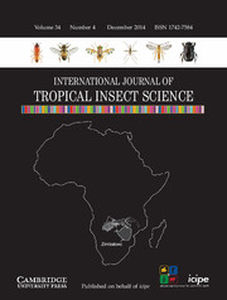Article contents
Windborne migration of Heliothis armigera (Hübner) (Lepidoptera: Noctuidae) in India
Published online by Cambridge University Press: 19 September 2011
Abstract
Comparisons of numbers of Heliothis armigera moths, caught in a light trap at ICRISAT Center (17°N 78°E), with wind direction has provided circumstantial evidence for windborne migration in India. The evidence is less convincing than that from northern Europe, possibly because flying populations are present around the trap throughout the year, although varying greatly in numbers between seasons. Comparisons were made for occasions when trap catch rose or fell over four successive nights with a correlation coefficient ≥0.9 and rate of catch change > 1 moth/night. Catch rises were used from only those parts of the lunar cycle when falls would be expected, and catch falls from those parts when rises would be expected. During the period May 1977 to December 1983 there were 23 rises and 16 falls. Rises occurred mostly during the seasons of maximum catch. All seven rises in February–April occurred with southeasterly winds, even though such winds blow on average only half the time in those months. These rises sometimes coincided with onset of southeasterlies; at other times there was a lag, consistent with flight from distant sources. Similar migrations seem possible in October–December, sometimes in the presence of cyclones over the Arabian Sea. The evidence for migration in August at ICRISAT, and in all seasons at ICRISAT Sub-Center, Hisar (29°N 76°E), is inconclusive.
Résumé
Des comparaisons effectuées sur un certain nombre de noctuelles Héliothis armigera, prises dans un piège lumineux au centre d'ICRISAT (17°N 78°E), en rapport avec la direction du vent ont fourni l'évidence indirecte d'une migration dans le sens du vent en Inde. Cette évidence est toutefois moins convaincante que celle d'Europe du Nord, peut-être en raison de la présence de populations volantes aux alentours du piège tout au long de l'année même si ce nombre varie fortement d'une saison à l'autre. Des comparaisons ont été effectuées lorsque les prises augmentaient ou diminuaient sur quatre nuits successives avec un coefficient de corrélation ≥0.9 et un taux de variation de prise > 1 papillon/nuit. Les augmentations de prises ont été utilisées seulement pour ces périodes du cycle lunaire durant lesquelles l'on s'attend à des chutes; et les diminutions de prises pour les périodes de cycle durant lesquelles l'on s'attend à des augmentations. Au cours de la période allant de mai 1977 à décembre 1983, il y a eu 23 augmentations et 16 diminutions. Les augmentations sont survenues principalement durant les saisons de prise maximum. Ces sept augmentations de février à avril ont eu lieu avec des vents venant du sud-est, même si ces vents soufflent en moyenne seulement la moitié du temps au cours des mois en question. Ces augmentations ont quelquefois coïncidé avec la levée de ces vents direction sud-est; à d'autres moments, il y a eu un décalage compatible avec des vols provenant de sources lointaines. De semblables migrations semblent possibles en octobre-décembre, parfois en présence de cyclones sur la mer d'Arabie. Les évidences d'une migration en août à ICRISAT, et à toutes les saisons à la sous-station d'ICRISAT, Hisar (29°N 76°E), ne sont pas concluantes.
Keywords
- Type
- Symposium IV: Migration and Dispersal of Tropical Noctuid Moths
- Information
- International Journal of Tropical Insect Science , Volume 8 , Issue 4-5-6: Recent Advances in Research on Tropical Entomology , December 1987 , pp. 599 - 604
- Copyright
- Copyright © ICIPE 1987
References
REFERENCES
- 7
- Cited by




